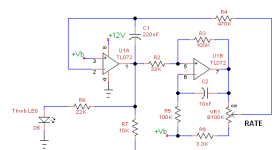so this is a nut i've been trying to crack for a while.
almost every approach i've seen published has taken the signal from pin 7 -- the square wave output of the op amp -- as their starting point. some use a capacitor to smooth it out but the problem with that is that the capacitor's value is fixed and thus so is the speed of the ramp, so while it may be just right in the middle, it will be too slow for fast LFO speeds and too fast for slow LFO speeds.
to get a satisfying ramp that reflects the true shape of the LFO the LED current needs to be taken from the LFO output itself.
the best implementation i've seen of it in action is here:
but they don't provide schematics since these are mods they're offering for sale -- trade secrets i presume, though i haven't reached out to ask if they'd be willing to share.
the best implementation i've seen with a schematic attached is here:
with the circuit posted here:
this person took the output of the LFO before the 3.9M resistor, cancelled the DC bias using a large cap and resistor combo and then drove the LED with an op-amp configured as a current driver. and it looks pretty damn good, but there's still a little room for improvement -- because the DC bias is cancelled completely, half of the waveform is below zero and thus clipped, and so the LED spends half its time completely off. my ideal would be to have the LED only hit zero at the bottom of the wave, so it seems like the answer is trickling in a little bias current from the reference voltage. it only needs a little bit so a very large (~15M) resistor is in order. this is working really well for me, at least in simulation. one possible remaining tiny issue is that the faster waveforms are higher in amplitude than the slow ones, but if you dial it in for the slowest one, having faster ones clip a little at zero and overshoot maximum brightness by 2mA at the peaks doesn't seem like a big problem. here's the simulation, let me know what you think:











